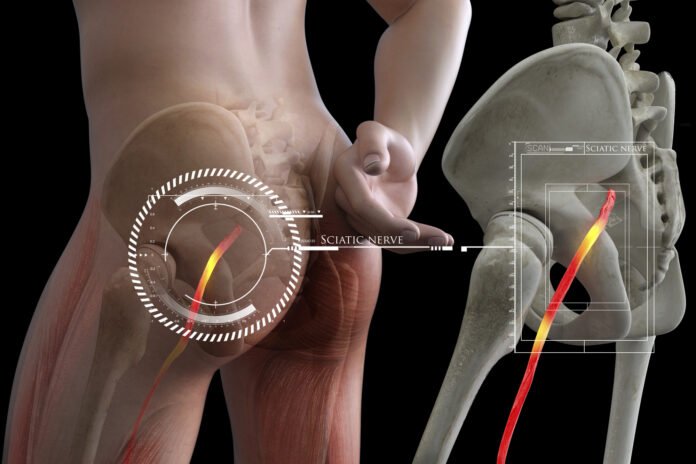Sharp pain shooting down your leg, tingling numbness, and weak muscles – these yucky symptoms could be sciatica. It’s a common problem that bothers many people and makes it hard to do everyday things.
But don’t worry! This guide will help you understand sciatica. We’ll discuss what causes it, like bulging discs or tight muscles, and tell you when to see a doctor.
By learning about sciatica, you can take charge, return to feeling good, and move around easily!
Table of Contents
Causes of Sciatic Nerve Irritation
When something presses on or compresses the sciatic nerve, it can cause inflammation. This inflammation is the primary cause of the pain associated with sciatica treatment.
While seeking sciatica treatment from a reputable clinic is recommended, it’s also beneficial to be aware of the causes and symptoms to know when to pursue such treatment. Here are some common causes of sciatic nerve irritation:
- Spinal Stenosis – This occurs when the space inside the spine becomes smaller, putting pressure on the spinal cord, including the sciatic nerve.
- Muscle Spasms – Tight or strained buttock muscles can compress the sciatic nerve.
- Piriformis Syndrome – Piriformis Syndrome – The piriformis muscle, located deep in the buttocks area, can irritate the sciatic nerve if it becomes inflamed or contracts too much.
- Herniated Disc – The discs between the vertebrae in the spine act as cushions. When the soft inner part bulges out, a herniated disc occurs, potentially putting pressure on the sciatic nerve. In severe cases, a herniated disc may require surgical intervention to remove the portion compressing the nerve and alleviates sciatica symptoms.
- Pregnancy – The growing baby and shifting weight can pressure the sciatic nerve.
- Spondylolisthesis – This happens when a vertebra slips forward over the one below it, potentially pinching the nerve roots and affecting the sciatic nerve.
- Less Common Causes – In rare cases, sciatica can be caused by infections, tumors, or blood clots in the spine.
Symptoms to Watch For
Sciatica presents a distinct set of symptoms that can vary in intensity and duration. Here’s a breakdown of the telltale signs to watch out for:
- Pain: The main symptom is pain that travels from the lower back down one leg. This pain can range from dull to sharp, shooting. Some individuals describe it as an electric shock traveling down the leg.
- Numbness: You might experience numbness or tingling (pins and needles) along the sciatic nerve path. This numbness can affect the buttock, leg, and foot.
- Weakness: Your leg may feel weak, making standing, walking, or climbing stairs difficult. Some people report difficulty lifting their feet or toes due to weakness.
- Burning Sensation: A burning feeling along the leg can also be a symptom of sciatica. This burning sensation can be constant or come and go.
- Pain Worsening with Certain Activities: Activities that strain the lower back or sciatic nerve can exacerbate the pain. These can include sitting for long periods, bending over, twisting the spine, or pulling the back muscles.

When To Seek Treatment
If you experience any of these symptoms, it’s crucial to consult a healthcare professional. Getting diagnosed and treated early on can help control the pain, stop the nerve from getting more damaged, and allow you to resume your normal daily routine faster.
- Severity of Pain: If you can’t stand the pain and it interrupts your daily activities, such as walking, working, or sleeping, it’s essential to see a doctor. Unrelenting pain can be a sign of a more serious underlying condition.
- Loss of Bowel or Bladder Control: This severe symptom indicates potential nerve damage and requires immediate medical evaluation. Loss of control over these functions is a neurological emergency.
- Progressive Weakness: If you have difficulty walking due to the worsening weakness in your leg, it may suggest ongoing nerve damage that needs medical intervention.
- Fever or Chills: These symptoms, along with sciatica pain, could indicate an infection in the spine, requiring prompt medical attention. Early diagnosis and treatment of a disease are crucial to prevent complications.
- Sudden or Worsening Pain: If you experience a sudden and severe onset of sciatic pain, especially after a fall or injury, seek immediate medical attention. This could indicate a severe injury requiring prompt evaluation.
- No Improvement with Self-Care: If you’ve tried home remedies like rest, pain relievers, and heat/ice therapy for several weeks without significant improvement, consult a doctor. They can assess the cause and recommend a more targeted treatment plan.
Conclusion
Ignoring sciatic symptoms can lead to further nerve damage and prolonged discomfort. You can effectively manage this condition by familiarizing yourself with the causes, recognizing the warning signs, and seeking timely medical attention.
Embrace self-care measures, but don’t hesitate to consult a healthcare professional when pain persists or worsens. With the right approach, sciatica’s debilitating effects can be mitigated, allowing you to regain your active lifestyle.
Emma Thompson
Emma Thompson is a wellness advocate passionate about empowering individuals to take charge of their health. She aims to raise awareness about common conditions like sciatica through informative articles. Emma’s mission is to equip readers with the knowledge to make informed decisions and improve their well-being.
Apart from this, if you are interested to know more about Lower back pain then visit our Health category
























